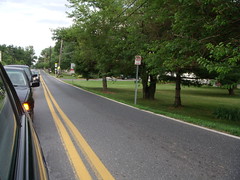I'm very fortunately to have my entire family nearby for the holidays. Our family has deep roots here, and my brothers and sisters have all stayed pretty close to the DC area. But they are all spread out over suburban Maryland, and they have a diverse set of problems they face getting around.
This year, we celebrated Thanksgiving with my sister and brother-in-law at their house in the Silver Spring enclave of Spencerville, a semi-rural area just west of Burtonsville in northeast Montgomery County. My brother-in-law tries to stay involved in planning issues in his area, such as the revitalization of Burtonsville, so we have plenty to talk about at these family gatherings. But this time he struck me with a problem I'd never really considered: during rush hour, he can't get out of his neighborhood.
There are two main roads cutting east to west across the area, MD-198 and Briggs Chaney Road. They are both two-lane highways with few traffic lights and horrible congestion problems. I consider them two of the primary reasons for the justification of the ICC. Along the section between New Hampshire Avenue and Old Columbia Pike, 198 has no traffic lights, a speed limit of (I'm pretty sure) 45, and virtually no pedestrian facilities. Briggs Chaney Road has a few traffic lights, but it is not much better. When these roads experience rush hour traffic, it is virtually impossible to make a right turn on to 198 from a neighborhood street, and don't even think about a left turn.
So what do they do in the exurbs when they face problems like this? Well, my brother-in-law has been attending meetings discussing the widening of 198 between New Hampshire and Old Columbia, which he agrees will be a not-so-smart idea. The state is building a freeway through the area, why the heck should the people of Spencerville have to widen their roads? Wouldn't this option encourage people to use the "rural" roads from which the ICC is supposed to be removing traffic?
He then went on to tell me about another solution, one that I rather liked: traffic circles. These have been a success a few miles away on Fairland Road. They don't induce more traffic like a widening would, and access to and from the neighborhoods would be greatly improved. It would slow traffic down, too, which would discourage using these once-country roads as short cuts between Rockville and US 29. At the very least, a traffic signal or stop sign at a few intersections would do the trick.
I don't believe this is an isolated problem. Rapidly-suburbanizing Bowie, Upper Marlboro, and Clinton all have similar road construction to the Spencerville area. Unfortunately, Prince George's County has an affinity for wider roads at the expense of smart development. Loudon County already has plenty of traffic woes, I'm sure inability to egress a neighborhood is among them in some areas. Same with Prince William. I'll bet even parts of Fairfax have some issue with this.
The fact is, our outer suburbs already utilize a disproportionate amount of government coffers with the cost of running utilities, road construction and maintenance, school busing, postal delivery, and other services that good urbanism here is just as important as it is down town. Otherwise, we face the expensive prospect of concentric rings of highways serving more of the environmentally unfriendly spread-out suburban landscape.
I hope my brother-in-law helps win the fight against road widening, and I hope he and his neighbors are successful in pushing for a smarter way to get out of their neighborhoods during rush hour. But most of all, I hope Spencerville sets a good example for Bowie, Upper Marlboro, Dale City, Ashburn, and the rest of DC's exurbs.
skip to main |
skip to sidebar
Facebook
Who is
- Davemurphy
- I'm a native of inside the Beltway. I am a geographer by trade.
Regional
SE/SW
NE and vicinity
NW
NoVa
MoCo
B-More Area
All Over
Other American Cities
More Stuff I Read
| Blog: |
| Imagine, DC |
Topics: |
| Washington, DC, urban planning |





No comments:
Post a Comment